To everyone wondering why I haven’t posted for while, sorry, but it’s been a busy month with lots of travel, collections, and of course new discoveries. Didn’t always have my computer with me nor have internet access. Now that I’m back on the continent I’ll try to make up for it and fill in the gaps.
I have to start with some sad news though. This busy month was too much for my boots. They weren’t new when I left Durango but they were in fine shape. Hard hiking over hot and sharp lava just did them in. But they went out as real troopers.

They were good boots. R.I.P.
Inter-island travel was the main theme this month with the goal to collect all the taxa in the genus Froelichia. So the sight below became kind of normal. Most of the time we had been staying on the island of Santa Cruz where Puerto Ayora, the largest town in the islands is found and the Charles Darwin Research Center. But there is only one species of Froelichia occurring on that island. For further collecting I needed to visit three additional islands: Pinzon, Floreana, and Isabela.
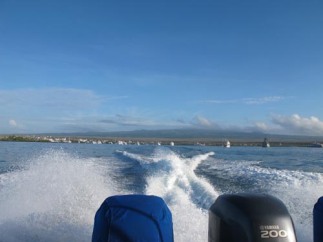
Leaving Puerto Ayora and Isla Santa Cruz on an inter-island ferry.
Pinzon
Isla Pinzon is a small island located west of the island of Santa Cruz. The island is not open to the public except for some diving off its coast. Thus there is no development and the natural ecosystem is very well preserved. My goal with visiting Pinzon was observation and collection of Froelichia nudicaulis ssp. curta. This taxon was first collected in 1905 and had only been collected twice since and only from the top of the island. Due to the closed nature of the island this trip was coordinated with the Galapagos National Park and I accompanied a group of park rangers traveling to Pinzon to census tortoise nests.
The climb to the summit at about 450 m (1475 ft) passed through principally dry forest vegetation (ie. spiny and prickly) and the dry forest extends all the way to the summit unlike on other larger islands. The way has a semblance of a trail but is still mostly climbing over rocks and working through the dense vegetation.

“Trail” up to the summit of Isla Pinzon
Arriving at the summit was great although I was quite hot and tired and there I did find Froelichia. But as I expected it was only there. While it’s hard to account for every plant it appears the distribution of this taxon covers no more than about 3-5 hectares.
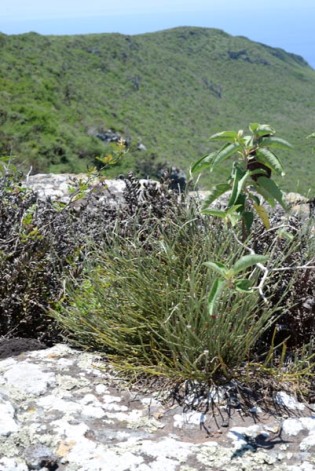
Froelichia nudicaulis ssp. curta at the summit of Isla Pinzon
I also had the chance to see an endemic Galapagos hawk (Buteo galapagoensis) who followed me up the last quarter of the climb and stayed near me the whole time I was at the summit. The bird was banded and living on an uninhabited island thus the only human contact it would know was that of park rangers and it showed no fear of humans.

Galapagos Hawk near the summit of Isla Pinzon. Isla Santa Cruz can be seen in the distance.
Floreana
Following Isla Pinzon I made my way south to the island of Floreana. Floreana is the island with the longest history of human habitation although today only 130 people live on the island. Tourists are also much less common than on the other large islands. This gives the island a much more remote and isolated feel. One I really enjoyed. My goals for visiting Floreana were really two-fold. One was collection of multiple species of the endemic genus Scalesia for a project my collaborator Dr. Gonzalo Rivas has initiated studying its diversification and radiation. I’ll say more about this later as during April and May I will be working on molecular phylogenetics of the group to accompany his detailed ecological and distributional assessment. Secondly I wanted to search for Froelichia nudicaulis ssp. nudicaulis. This species has been much misinterpreted but detailed examination showed that this taxon had been collected on the islands of Floreana and Santiago. It was first collected in 1835 by Charles Darwin and the species described from his collections. It was next collected in 1852 on Floreana and has not been seen on the island since. Only one collection from 1905 is known from Santiago and again it has not been seen since. Using knowledge of potential ecosystem associations and historical knowledge of potential visited areas in the 1800s I set out to see if I could find evidence of Froelichia still occurring on the island.
Collecting Scalesia took me to the highest point of the island on Cero Pajas. Here I was looking for two taxa in S. pedunculata, the typical variety and the much more rare S. peduculata var. parviflora. It also got me to wonderful area Punta Cormoran for the Floreana endemic S. villosa.

Scalesia forest on the east slope of Cerro Pajas, Isla Floreana

Scalesia pedunculata var. parviflora on Isla Floreana

Park ranger Anibal San Miguel assisting with collection of Scalesia on Floreana.

Scalesia villosa at Punta Cormoran, Isla Floreana.
Searching for Froelichia was not as fruitful as I had wished. I searched various dry forest areas but was unable to find any signs of the genus. It is disappointing for sure as it tells us it is likely extinct from the island and the taxon is probably extinct across its full distribution. I wasn’t able to search on Isla Santiago but other vegetation surveys and ecological investigations there have not happened upon it over the last 100 years. The taxon was likely never very common to begin with and likely succumbed to the voracious appetite of introduced goats – the last of which was finally eradicated from the island of Floreana in 2015. Unlike many dry forest species which have spines or toxins to repel herbivores Froelichia is mostly defenseless – its adaptation allowing it to survive in the open lava environment was not well-suited to introduced animals.

Dry forest south of Post Office Bay on the north side of Isla Floreana. Looking east toward Punta Cormoran.
In addition to work I enjoyed a couple days on Floreana with the family.
Isabela
The last island I needed to visit was the largest of the Galapagos, Isabela. Two taxa of Froelichia, F. juncea ssp. juncea and F. nudicaulis ssp. lanigera occur on the island. Froelichia nudicaulis ssp. lanigera grows toward the northern side of the island (and on the island of Fernandina) favoring high elevation areas. Due to time and finances I wasn’t able to get to that species on this trip – maybe another time – but my colleague was able to sample some for me for these current studies from Fernandina. Instead I focused on covering the elevational range of F. juncea ssp. juncea which grows from sea level up to the volcano tops at the southern end of the island. The species has a preference for open lava flows where it is a pioneer species. At higher elevations it is actually quite common being one of the more dominant species in the community.
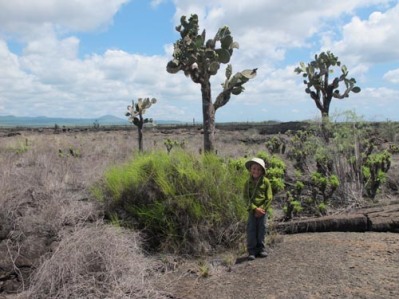
My field assistant Emiliano with Froelichia juncea ssp. juncea on open lava flow near the coast at the southern end of Isla Isabela. It co-occurs with the endemic species Opuntia echios and Scalesia affinis.
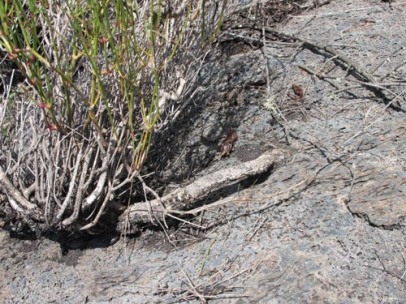
Base of Froelichia juncea appearing to grow out of pure rock!

Froelichia juncea ssp. juncea near Volcan Chico, an area of fumarol activity on the east side of Volcan Sierra Negra.

Me and Froelichia juncea ssp. juncea at Volcan Chico.

Dr. Gonzalo Rivas from the Universidad San Francisco de Quito and I at the top of Volcan Sierra Negra looking over the 10 km wide caldera toward the area of the November 2005 eruption.
While the collection of Froelichia from southern Isabela was very successful I did discover one potentially disturbing finding. Individuals of Froelichia near the town of Puerto Villamil were infected with scale insects and the infestation was negatively affecting the plant’s health and ability to fully set flower. The scale is a member of the genus Ceroplastes and this species, C. cirripediformis is a non-native introduced pest. The fact that it is attacking native vegetation is worrisome and something that will need to be monitored into the future.

Froelichia juncea ssp. juncea infected with scale (Ceroplastes sp.) on southern Isabela.
While our time on Isabela was shorter than that on some other islands we were able to do a few other activities as a family. Both Aurea and Emiliano were able to accompany me on my search for Froelichia on Volcan Sierra Negra – which was an incredible hike even if we had never encountered the plants. We knew Ian wouldn’t enjoy the hot sun all day and we were lucky enough to find someone to babysit him.

Aurea at the trailhead for Volcan Sierra Negra
We were also able to go on a tour which included snorkeling to see seahorses, sharks, and turtles. Emiliano was able to go and float in a life jacket since his swimming is not quite what it should be for snorkeling and our guide was great to pay extra attention to him and help him around the water. He loved it as it opened up a new world of creatures for him.
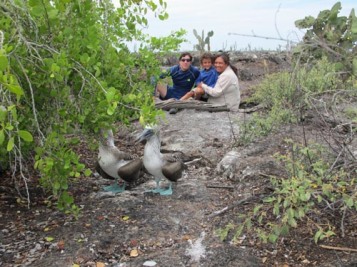
Us with a pair of Blue Footed Boobies (Sula nebouxii excisa)

Aurea snorkeling with a Galapagos Green Sea Turtle (Chelonia mydas agassisi)
Following Isabela we returned to Santa Cruz for a busy five days of wrapping up research, writing some reports, depositing specimens, visiting a few favorite local spots and cleaning up our rented house before taking off for mainland Ecuador. After 2.5 months we had gotten attached to living in Galapagos and we are truly going to miss our temporary home. Even with leaving we want to go back and the extensions to the research I’ve done will hopefully be able to make that a reality.

Emiliano with a map of the Galapagos on a wall outside the park headquarters.
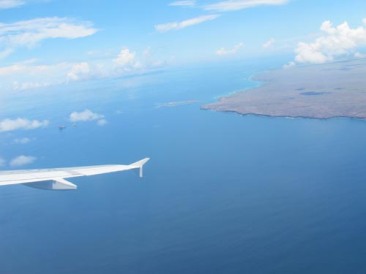
Leaving Isla Baltra looking out over the NE side of Isla Santa Cruz, Islas Plazas, and Rocas Gordon (just over the wing)



